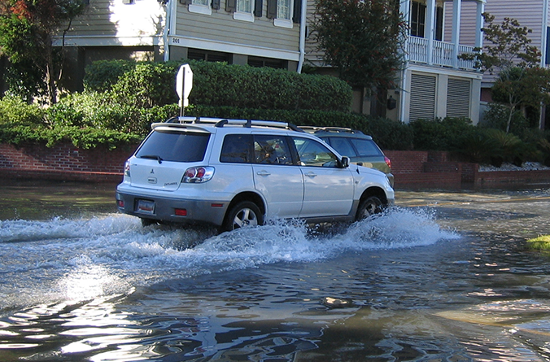A U.S. interagency report from NASA, NOAA and the U.S. Geological Survey states sea level rise over the next 30 years will be between 25 and 35 centimetres (10 to 14 inches) on the Atlantic seaboard, 35 to 45 centimetres (14 to 18 inches) along Gulf of Mexico coasts, and 10 to 20 centimetres (4 to 8 inches) on the country’s Pacific coast.
The data leading to these forecasts combine observed satellite altimeter and Earth-based tidal gauge measurements. Satellites have detected accelerating rates of sea level rise since 1993 which suggests the higher numbers in these forecasts will be closer to the likely outcome.
For coastal towns and cities, the foreknowledge should allow them to consider one of two strategies:
- An organized retreat inland to higher ground that involves both above and below-ground infrastructure relocation.
- A buildup of coastal defences that includes artificial and natural barriers to deal with inundations from catastrophic weather events and nuisance floods that accompany high tides.
Rising sea level is associated with global climate change. As atmospheric temperatures rise, so does the temperature of the ocean causing thermal expansion. Also, a warming atmosphere causes glacial melt which today can be observed both in alpine and continental glaciers.
But there is something else playing a part. That’s the Moon. Every 18.6 years the oceans of the world experience higher tides because of what is a wobble in our lunar companion’s orbit. The wobble causes higher tides in one part of the cycle, and lower tides at another point in time. The 2030s should have us at the high point just when global warming will likely have exceeded 1.5 Celsius (2.7 Fahrenheit) in mean temperature rise, the IPCC’s stated low-threshold target that it wants us not to exceed. Not to throw a wet sponge on this, a new forecast states that the next El Nino cycle beginning in 2024 may push us over the 1.5 mark, a frightening consequence coming from our procrastination to address climate change.
Tools for Policymakers and Planners
Although the reports are foreboding, NASA wants to help homeowners and community planners to better deal with the threat of sea level rise. It has established a Sea Level Change portal as well as a Sea Level Projection Tool to provide real-time observations and global projections that go out as far past 2150. These projections cover six different climate models looking at the latest scientific research and data collection for ocean thermal expansion, alpine, Greenland and Antarctic deglaciation, and contributions from other land water storage sources (rivers, lakes, aquifers).
For homeowners and municipal planners of coastal communities, the coastal threat is being well documented by science. Those contemplating ownership of a home next to the sea should be going into these types of transactions with eyes wide open. But rising sea levels seem to have little to no impact on coastal home purchases.
A new publication, “Housing Market Response to Sea-Level Rise in Florida,” written by Georgia State University professors Risa Palm and Toby Bolsen illustrates just how little sea level rise is impacting consumers. In a survey of 680 Miami realtors, the researchers asked if buying and selling of homes were being influenced by new flood maps that projected future areas of risk in South Florida. The realtors surveyed stated that the market remained hot for coastal properties and that they were optimistic about future sales even though media coverage in South Florida continued to report stories on sea level rise.
When asked about property insurance, realtors noted that there may be a time in the future when the risk cost could negatively impact sales. But coastal property purchases, they stated, were not about the risk for most buyers, but rather about the amenity of being by the sea.
Despite realtor optimism, the cost of flood policies continues to rise as do the minimum deductibles. Is this uniform across all U.S. seaboards? No. In some high-risk-identified flood zip code areas, some insurers have stopped offering policies. But most continue to provide give high-risk areas with insurance coverage. What’s changed is that insurers are instituting stricter underwriting guidelines making it more difficult to qualify upon renewal which then leaves homeowners dependent on government relief in the event of a flood. Other insurers are providing homeowners with guidance about home upgrades to plumbing, electrical and HVAC systems, and even flood protection landscaping advice.
There will be a tipping point when insurers and homeowners will no longer find common ground. But based on the Georgia State study for South Florida, we are still not there. But as sea levels rise into the 2030s, that tipping point may soon arrive.
















